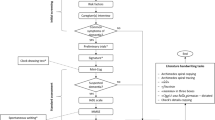Abstract
Background and aims: Dysgraphia is a recognized clinical finding in delirium, but few studies have evaluated handwriting, and results have been inconsistent. In particular, handwritten signatures, which may be a motor automatism, have not been previously evaluated in delirious patients. The aim was to assess abnormalities of signature and spontaneous writing in delirious patients and to investigate their clinical utility in the detection of delirium. Methods: Secondary analysis of data was collected from a prospective observational study of acutely ill inpatients 70 years or older. Mini-Mental State Examination, Confusion Assessment Method, Delirium Rating Scale, Activities of Daily Living, and APACHE II were administered to each subject, their signatures were evaluated from the consent form, and their handwriting from the spontaneous sentence written as part of the MMSE. Results: The signatures of patients with delirium were significantly more impaired than those without (Chi-square= 14.749, df=1, p<0.0001). The sensitivity of the signature for delirium as defined by CAM was 0.54, with specificity of 0.88. Handwriting abnormalities of omission (p=0.018), illegibility (p=0.034) and spelling (p=0.035) were significantly more common in delirious patients than others (Chi-square with Fisher’s Exact tests. This difference was mainly attributable to the fact that a large number of delirious patients were unable to provide any response to the handwriting questions. Conclusions: An abnormal signature may be an indicator of delirium. People with delirium have handwriting problems, which may be partly caused by cognitive impairment but also by disorders of motor function.
Similar content being viewed by others
References
Benson DF. Aphasia, Alexia, and Agraphia. New York, Churchill Livingstone, 1979.
Roeltgen DP. Agraphia. In Feinberg TE, Farah MJ, eds. Behavioural neurology and neuropsychology. New York: McGraw-Hill, 1997: 209–17.
Brain L. Speech disorders. Aphasia, Apraxia and Agnosia. 2nd ed, London, Butterworth, 1965.
Graham NL. Dysgraphia in dementia. Neurocase 2000; 6: 365–76.
Inouye SK, Viscoli CM, Horwitz RI, Hurst LD, Tinetti ME. A predictive model for delirium in hospitalized elderly medical patients based on admission characteristics. Ann Intern Med 1993; 119: 474–81.
American Psychiatric Association: Diagnostic and Statistical Manual of Mental Disorders, fourth edition. Washington, DC. American Psychiatric Association, 1994.
Chedru F, Geschwind N. Writing disturbances in acute confusional states. Neuropsychologia 1972; 10: 343–53.
Aakerlund LP, Rosenberg J. Writing disturbances: an indicator for postoperative delirium. Int J Psychiatry Med 1994; 24: 245–57.
Macleod AD, Whitehead LE. Dysgraphia and terminal delirium. Palliat Med 1997; 11: 127–32.
Patten SB, Lamarre CJ. Dysgraphia. Can J Psychiatry 1989; 34: 746.
Baranowski SL, Patten SB. The predictive value of dysgraphia and constructional apraxia for delirium in psychiatric inpatients. Can J Psychiatry 2000; 45: 75–8.
Caraceni A, Grassi L. Delirium. Acute confusional states in palliative medicine. Oxford, New York: Oxford University Press, 2003: 48–50.
Folstein MF, Folstein SE, Mc Hugh PR. Mini-mental state: a practical method for grading the cognitive state for the clinician. J Psychiatr Res 1975; 12: 189–98.
Critchley M. Aphasiology and other aspects of language. London: Edward Arnold, 1970.
Adamis D, Martin FC, Treloar A, Macdonald AJD. Capacity, consent and selection bias in a study of delirium. J Med Ethics 2005; 31: 137–43.
Inouye SK, van Dyck CH, Alessi CA, Balkin S, Siegal AP, Horwitz RI. Clarifying confusion: the confusion assessment method. A new method for detection of delirium Ann Intern Med 1990; 113: 941–8.
Trzepacz PT, Baker RW, Greenhouse J. A symptom rating scale for delirium. Psychiatry Res 1988; 23: 89–97.
Knaus WA, Draper EA, Wagner DP, Zimmerman JE. APACHE II: a severity of disease classification system. Critical Care Medicine 1985; 13: 818–29.
Katz S, Downs TD, Cash HR, Grotz RC. Progress in development of the index of ADL. Gerontologist 1970; 10: 20–30.
Benson DF, and Cummings JL. Agraphia. In Vinken PJ, Bruyn GW, Klawans HL, Frederiks JAM, eds. Clinical Neuropsychology. New York: Elsevier, vol 45, 1985.
Slavin MJ, Phillips JG, Bradshaw JL, Hall KA, Presnell I. Consistency of handwriting movements in dementia of the Alzheimer’s type: a comparison with Huntington’s and Parkinson’s diseases. J Int Neuropsychol Soc 1999; 5: 20–5.
Agarwal P, Frucht S, Myoclonus. Curr Opin Neurol 2003; 16: 515–21.
Marsden CD, Hallett M, Fahn S. The nosology and pathophysiology of myoclonus. In Marsden CD, Fahn S, eds. Movement disorders 1 and 2 reissue. Oxford, Boston: Butterworth-Heinemann, 1995: 196–248.
Author information
Authors and Affiliations
Corresponding author
Rights and permissions
About this article
Cite this article
Adamis, D., Reich, S., Treloar, A. et al. Dysgraphia in elderly delirious medical inpatients. Aging Clin Exp Res 18, 334–339 (2006). https://doi.org/10.1007/BF03324668
Received:
Accepted:
Published:
Issue Date:
DOI: https://doi.org/10.1007/BF03324668




